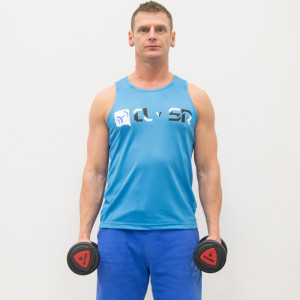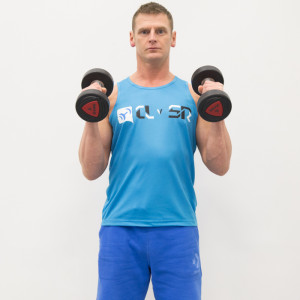Dumbbell Hammer Curl
Starting position:
- Grasp the two dumbbells using a closed, neutral grip.
- Stand straight with feet shoulder width apart, keeping a slight bend in the knees.
- Extend elbows (palms should be facing the outer thighs).
- Keep upper arms tucked against torso and perpendicular to the floor.
Upward movement/concentric phase:
- Flex the elbow of one arm. The dumbbell should be approaching the front of your shoulders with full elbow flexion.
- Maintain the dumbbells in the neutral grip position.
- Keep standing straight and upper arms tucked against side of torso.
Downward movement/eccentric phase:
- In a controlled fashion, allow the elbow to extend back to the starting position.
- Keep standing straight, only the elbow joint is to be moving as it extends.
- Maintain the dumbbells in the neutral grip position.
- Pause before beginning the next repetition.
- Repeat the upward and downward movement with the opposite arm, alternating arms.
Exercise Data
FAQ'S & FACTS ABOUT Dumbbell Hammer Curl
What Is a Dumbbell Biceps Hammer Curl?
A Hammer curl is a resistance exercise, which involves the primary elbow flexors, the brachialis and biceps brachii. The positioning of the hand activates the brachioradialis to a greater extent than in the supinated grip (as in a traditional standing biceps curl). The hammer curl grip is a closed, neutral grip with palms facing inward.
This exercise is performed with dumbbells. The concentric portion of the lift is elbow flexion, which involves the lifting of the weight. The eccentric portion is elbow extension, which involves the descent of the weight.
The purpose of the hammer curl is to strengthen the biceps while promoting hypertrophy (increases in size) of the biceps.
Why Do Dumbbell Biceps Hammer Curls?
Hammer curls strengthen and increase the size of the biceps brachii, brachialis and brachioradialis. Although it is primarily an exercise for aesthetics, hammer curls also serve as an auxiliary exercise that can increase strength involved in other multi-joint exercises.
Strategically implementing hammer curls in an exercise regiment complements a biceps exercise routine. Overall, activating the biceps muscle group with different angles, grips and lifting devices (e.g. barbells, dumbbells, cables, EZ bar) optimizes biceps strength and hypertrophy gains over time.
Anatomy Of A Dumbbell Biceps Hammer Curl
The biceps brachii is located on the front of the arm, originating at the shoulder and inserting in the elbow joint. It consists of two heads, the long head (outer portion) and the short head (inner portion). The long head tendon helps stabilize the shoulder joint and its origin is located at the tubercle and lip of the glenoid cavity of the scapula (shoulder blade). The short head origin is located at the coracoid process of the scapula. The long and short head unite as the muscle bellies run down the front of the arm. Both heads merge, sharing insertion into the radial tuberosity of the elbow joint.
The biceps brachii flexes the elbow joint and supinates the forearm. Supination refers to the simultaneous rotation of the wrist and elbow as the palm of your hand faces upward. Although the hammer curl is performed with a semi-pronated grip, placing greater tension on the brachioradialis, the biceps brachii are highly activated in this position.
The brachialis lies underneath the biceps brachii, originating at the front of the lower end of the humerus bone. Its insertion is located at the coronoid process of the ulna at the elbow joint. The brachialis is a primary elbow flexor.
The brachioradialis is a superficial muscle of the lateral forearm. Its origin is located at the lateral supracondylar ridge of the lower end of the humerus bone. It inserts at the base of the styloid process of the radius (where the forearm meets the wrist). The brachioradialis is most activated when semi-pronated during the hammer curl.
The subscapularis works in conjunction with the other three rotator cuff muscles to stabilize the shoulder joint during this exercise.
Variations Of A Dumbbell Biceps Hammer Curl
Prone incline dumbbell hammer curl, simultaneous hammer curl (flexing both arms at the same time as opposed to alternating arms as described above), seated hammer curls
How To Improve Your Dumbbell Biceps Hammer Curl
Strategically varying your hammer curl angle, position and repetition scheme (e.g. prone incline dumbbell hammer curls, seated hammer curl, simultaneous hammer curls) can result in optimal muscle activation that increases strength and hypertrophy of the biceps, brachialis and brachioradialis. Incorporating hammer curls in a biceps training regimen complements performance and size gains.
Emphasis on eccentric contractions, prolonging the eccentric portion of the contraction, may also be incorporated in a training program focused on increasing strength. This should be implemented accordingly and with adequate muscle recovery as eccentric contractions cause substantial damage to muscle tissue.
It’s important to note that your repetition and set volume will depend on your goals (e.g. strength, hypertrophy, muscular endurance). It is also important to allow adequate recovery days in between biceps training to allow muscles to repair.
Common Mistakes When Doing Dumbbell Biceps Hammer Curls
It is very common to observe an individual swinging their torso in efforts of lifting the weight with more ease. This compromises proper technique and biceps contraction. The biceps curl is a single-joint movement. The single-joint involved is the elbow joint. If you find yourself depending on momentum from swinging your torso to lift the weight, you may want to decrease the weight to prevent injury.
Standing on an unstable surface or with an unstable stance can also compromise technique. Your feet are your foundation and should be in a position of stability. If you are looking to maximize the contraction of your biceps, ensure that your feet are shoulder width apart with a slight bend in the knees. Stand on a flat surface. Standing with one foot in front of the other during a standing biceps curl can also compromise balance and decrease the potential for optimal muscle contraction.
Injuries Or Ailments & Their Effects Regarding Dumbbell Biceps Hammer Curls
If proper technique is not adhered to (e.g. swinging of the torso, dropping the weight quickly instead of controlling the descent on the eccentric portion of the lift), the likelihood of back and/or biceps injury increases.
Although rare, biceps tendon rupture may occur if warm-up is not sufficient and/or if intensity (load) is increased inappropriately.
If proper recovery is not implemented between training days for optimal muscle repair of the biceps, the biceps tendon becomes inflamed. Without proper rest and treatment, the inflammation remains and results in biceps tendonitis.
Impingement syndrome and rotator cuff injuries, in general, are commonly associated with biceps tendonitis/biceps tendinosis. Therefore, it’s best to avoid bicep exercises when addressing impingement syndrome/rotator cuff injury unless advised by a physical therapist.





